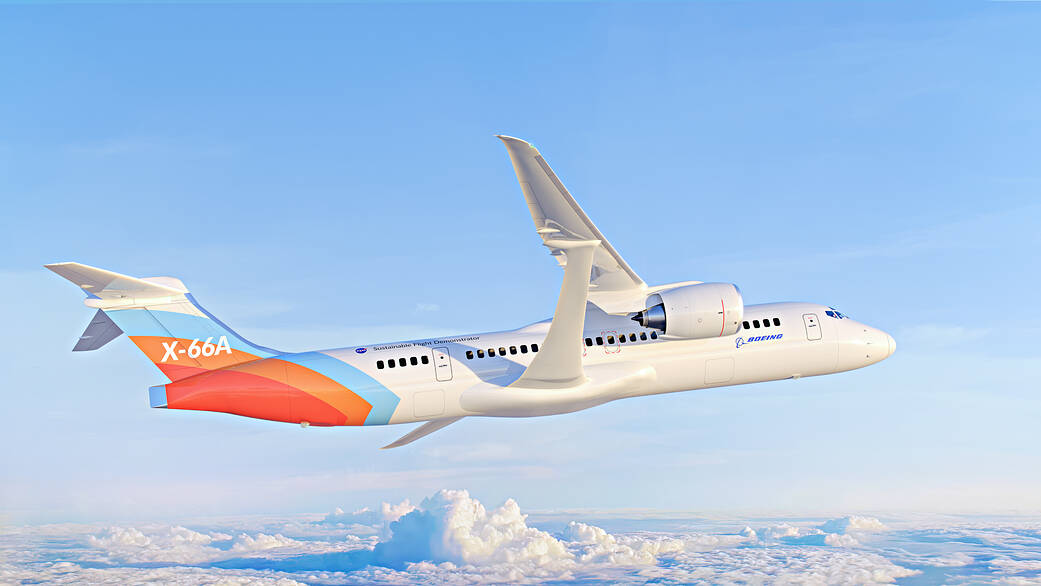Hamartia Antidote
Elite Member
- Nov 17, 2013
- 39,488
- 22,834
- Country of Origin

- Country of Residence

No, not the same tech as the x-65...

 www.space.com
www.space.com
The X-66A could "shape the future of aviation."

The X-66A plane will help the U.S. achieve the goal of net-zero greenhouse gas emissions by 2050. (Image credit: NASA)
NASA's latest experimental X-plane has received a name.
The United States Air Force has designated the plane, designed in conjunction with Boeing through NASA's Sustainable Flight Demonstrator project as the X-66A.
The X-66A is also the first X-plane designed specifically to help the U.S. achieve the net-zero goal for aviation greenhouse gas emissions, set out in the White House's U.S. Aviation Climate Action Plan, released in 2021.
NASA said in a press release that the X-66A could inform a new generation of sustainable single-aisle aircraft, planes that currently operated as the backbone of passenger-bassed air travel. As a result of their heavy usage, single-aisle aircraft account for around half of aviation greenhouse gas emissions across the globe. This means a sustainable version of such a craft could have a major impact on greenhouse gas emissions.
"At NASA, our eyes are not just focused on stars but also fixated on the sky. The Sustainable Flight Demonstrator builds on NASA's world-leading efforts in aeronautics as well climate," NASA Administrator Bill Nelson said in the statement. "The X-66A will help shape the future of aviation, a new era where aircraft are greener, cleaner, and quieter and create
new possibilities for the flying public and American industry alike."
NASA has a Funded Space Act Agreement with Boeing for the Sustainable Flight Demonstrator, which will see the space agency make an investment of $425 million over seven years. While NASA also provides the facilities and technical expertise for the project, Boeing and its partners will contribute an estimated $725 million to its funding.
Together with Boeing, this will see NASA build and fly a full-sized demonstration of the X-66A with extra long thin wings stabilized by diagonal struts, a design called a "Transonic Truss-Braced Wing."
X-plane status is granted by the Air Force to development programs such as that of the X-66A, which aim to create revolutionary experimental aircraft configurations. Usually reserved for research aircraft, the X-planes should test novel designs and new technologies that can be integrated into other aircraft rather than planes designed to be prototypes for full production.
"We're incredibly proud of this designation because it means that the X-66A will be the next in a long line of experimental aircraft used to validate breakthrough designs that have transformed aviation," Boeing chief technology officer Todd Citron said. "With the learnings gained from design, construction, and flight testing, we'll have an opportunity to shape the future of flight and contribute to the decarbonization of aerospace."
In the case of the X-66A, the X-plane status recognizes the design's Transonic Truss-Braced Wing configuration that, in combination with advancements in propulsion systems, and materials, could lead to a reduction of 30% in fuel consumption and fewer emissions in comparison to current "best-in-class" aircraft.
The aircraft is the latest in a long line of X-planes created by NASA, dating back to the 1940s, and the space agency's predecessor, the National Advisory Committee for Aeronautics (NACA), which founded an experimental aircraft program with the Air Force and the U.S. Navy. With its emphasis on emission reduction, the X-66A may just be one of the most important X-planes yet.
"To reach our goal of net zero aviation emissions by 2050, we need transformative aircraft concepts like the ones we're flying on the X-66A," associate administrator for NASA's Aeronautics Research Mission Directorate Bob Pearce said. "With this experimental aircraft, we're aiming high to demonstrate the kinds of energy-saving, emissions-reducing technologies the aviation industry needs."

NASA, US Air Force unveil new X-plane — the X-66A — to test wild wing design for fuel-efficient flight
The X-66A could "shape the future of aviation."
The X-66A could "shape the future of aviation."

The X-66A plane will help the U.S. achieve the goal of net-zero greenhouse gas emissions by 2050. (Image credit: NASA)
NASA's latest experimental X-plane has received a name.
The United States Air Force has designated the plane, designed in conjunction with Boeing through NASA's Sustainable Flight Demonstrator project as the X-66A.
The X-66A is also the first X-plane designed specifically to help the U.S. achieve the net-zero goal for aviation greenhouse gas emissions, set out in the White House's U.S. Aviation Climate Action Plan, released in 2021.
NASA said in a press release that the X-66A could inform a new generation of sustainable single-aisle aircraft, planes that currently operated as the backbone of passenger-bassed air travel. As a result of their heavy usage, single-aisle aircraft account for around half of aviation greenhouse gas emissions across the globe. This means a sustainable version of such a craft could have a major impact on greenhouse gas emissions.
"At NASA, our eyes are not just focused on stars but also fixated on the sky. The Sustainable Flight Demonstrator builds on NASA's world-leading efforts in aeronautics as well climate," NASA Administrator Bill Nelson said in the statement. "The X-66A will help shape the future of aviation, a new era where aircraft are greener, cleaner, and quieter and create
new possibilities for the flying public and American industry alike."
NASA has a Funded Space Act Agreement with Boeing for the Sustainable Flight Demonstrator, which will see the space agency make an investment of $425 million over seven years. While NASA also provides the facilities and technical expertise for the project, Boeing and its partners will contribute an estimated $725 million to its funding.
Together with Boeing, this will see NASA build and fly a full-sized demonstration of the X-66A with extra long thin wings stabilized by diagonal struts, a design called a "Transonic Truss-Braced Wing."
X-plane status is granted by the Air Force to development programs such as that of the X-66A, which aim to create revolutionary experimental aircraft configurations. Usually reserved for research aircraft, the X-planes should test novel designs and new technologies that can be integrated into other aircraft rather than planes designed to be prototypes for full production.
"We're incredibly proud of this designation because it means that the X-66A will be the next in a long line of experimental aircraft used to validate breakthrough designs that have transformed aviation," Boeing chief technology officer Todd Citron said. "With the learnings gained from design, construction, and flight testing, we'll have an opportunity to shape the future of flight and contribute to the decarbonization of aerospace."
In the case of the X-66A, the X-plane status recognizes the design's Transonic Truss-Braced Wing configuration that, in combination with advancements in propulsion systems, and materials, could lead to a reduction of 30% in fuel consumption and fewer emissions in comparison to current "best-in-class" aircraft.
The aircraft is the latest in a long line of X-planes created by NASA, dating back to the 1940s, and the space agency's predecessor, the National Advisory Committee for Aeronautics (NACA), which founded an experimental aircraft program with the Air Force and the U.S. Navy. With its emphasis on emission reduction, the X-66A may just be one of the most important X-planes yet.
"To reach our goal of net zero aviation emissions by 2050, we need transformative aircraft concepts like the ones we're flying on the X-66A," associate administrator for NASA's Aeronautics Research Mission Directorate Bob Pearce said. "With this experimental aircraft, we're aiming high to demonstrate the kinds of energy-saving, emissions-reducing technologies the aviation industry needs."

